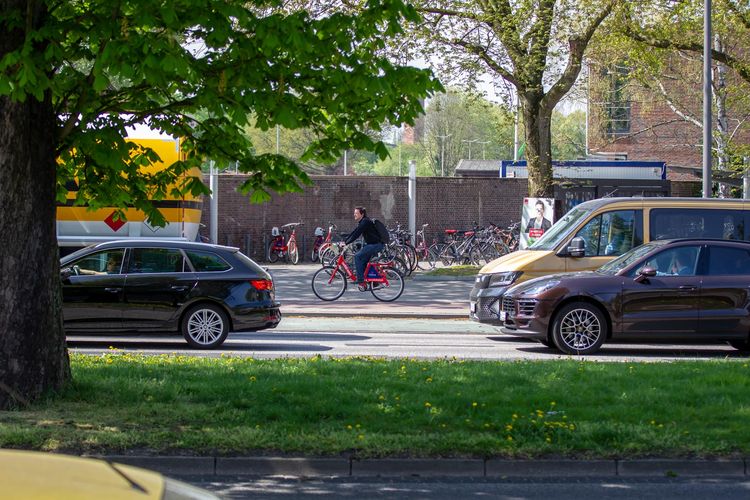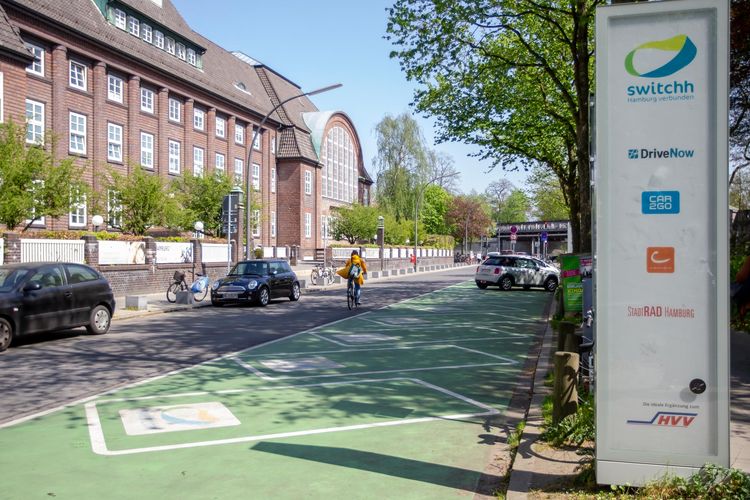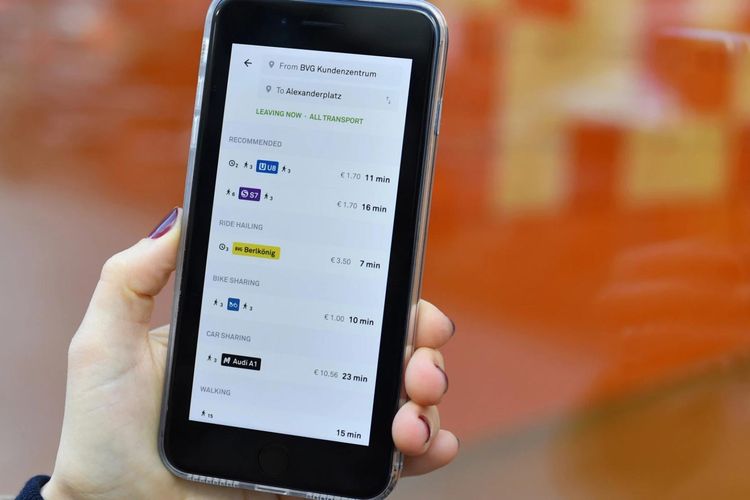08 August 2019
It is certainly convenient to have a car of your own. But if you only use it for yourself it is neither good for the traffic situation in general nor for the environment. There are already many alternatives to car ownership, such as using buses and trains, carsharing and bicycle hire, but these can generally only be found in their own individual Apps and in different locations. Multimodal services such as Switchh in Hamburg and Jelbi in Berlin want to link these methods of getting around town so as to combine the flexibility of individually-owned modes of transport with the efficiency of the public transport system.
Just get in, drive away, get out, and there you are at your destination – nothing seems as flexible as your own car when it comes to convenient travel from A to B. But what is easily forgotten: it is not always easy to find a parking space next to your own front door. And when you have struggled through the traffic congestion in the town and are where you want to be, sometimes you have to drive round and round the block in order to park. And it is also true that our vehicles are seldom used at their full capacity: investigations have shown that on average a private car contains just 1.5 people. This means that for most of the time the car is half empty or is standing unused in a public or private car park – and this for an average of 23 hours a day, as a survey by consultancy firm Roland Berger has found.
All the alternatives are already here
At least in towns, alternatives to the privately-owned car can be found on every street corner. In principle it is easy for many town dwellers to make use of multimodal transport, or in other words to make each journey with the most suitable transportation method: so for travel to the office it is bus or rail, for weekend shopping or a Sunday trip into the country there is the option of carsharing, an e-scooter can be used for a quick errand in town and a rented bike can cover the last few meters of the way. But the cars, bikes and more recently e-scooters which can be booked via mobile phone are usually to be found in different locations and almost never in the same App. If you want to make use of the entire mobility offering, you have to juggle different providers and their Apps – instead of simply finding the fastest, most convenient or most suitable means for the relevant journey.
© Marc CarrenaParking space at the door: if you want to change from a shared car to the train or from the train to the car, you do not have to look too far.
In any event, there seems to be great potential for shared mobility: depending on the local circumstances, carsharing vehicles can replace between three and ten private cars, as the German Environment Agency (UBA) has calculated. In fact in highly-populated city centres, more than 10 private vehicles can even be substituted, according to the Agency. However, this only applies for vehicles located at fixed carsharing stations, where the cars are collected from a car park and are then left there after use. In the case of popular and practical free-floating services, whose hire vehicles can be found and parked on every corner, studies indicate a different story. According to the UBA, in order that such services really can reduce congestion and contribute to environmental protection, they have to be linked in “as a mobility building block together with local public transport and other services such as bike sharing.”
Switchh: From underground to rented bike
And it is precisely this networking of rail, bus and shared means of transport that public transport operator Hochbahn AG in Hamburg has been trying to achieve since 2013. The idea behind its “Switchh” concept: in order that people can change conveniently from the railway to the carsharing vehicle or rented bike, the pathways must be as short as possible. In 2013 the first Switchh station was opened at the Berliner Tor railway hub, with eight parking spaces for carsharing vehicles and a town bike collection point right nearby. Now there are more than 60 stations all over Hamburg, where it is possible to pick up a rented car from Switchh partners car2go, DriveNow and Cambio. The ultimate intention is to establish up to 100 stations.
© Marc CarrenaOn your bike: Rented bikes are available at Underground stations for the last mile home or to the office.
Since 2017, Hochbahn has also gone directly into different districts of Hamburg in order to install decentralised Switchh points right on the doorsteps of the users. And really that is quite logical: if you know that the nearest carsharing car park is within walking distance and if you can find your rented car there in the morning and park it back there in the evening, you are more likely to leave your own car at home. Or you will get rid or your own car altogether. The Switchh stations, with their turquoise car parks, are intended to make the alternatives to car ownership not only more convenient and less complicated, but also more visible. As many people as possible of all ages should be made aware of the new opportunities for mobility in this way, as Hochbahn spokesperson Constanze Dinse explains.
© Marc CarrenaGreen and good: The brightly-coloured car parks of the Switchh stations are also intended to enhance the visibility of the alternative means of transport
En route to the App for Everything
The services can be used in the normal way via the suppliers’ Apps and also via the Switchh-Abo subscription offered by Hochbahn. For around nine euros a month, you can get 20 free minutes with car2go and DriveNow in Hamburg. And although occasional sharers like business travellers or tourists cannot be picked up directly from where they are staying, for local people who make a large number of journeys it really does make sense. They can have the location where the nearest car or bike of the Switchh partners is located displayed on a real time map in the App of the Hamburg Public Transport Association, HVV. However, the App does not include a route planner to show the route with the sharing partners to the desired destination. And in order to reserve and book, you are passed on to the App of the respective supplier, which also has to be installed on the Smartphone.
© Marc CarrenaThe goal: all of the various shared mobility providers in one app.
In order to link the different transport offerings digitally in the best possible way, Hochbahn wants to launch its own App by the end of the year. This App should make it easy to find, reserve, book and pay for the different means of transport that are available. Hochbahn has not yet stated finally which providers will be there at the launch. Discussions are being held with the current partners, but also with other mobility providers – including ridesharing service Moia, which has been on the road in Hamburg since mid-April.
The example of Vilnius
In the capital of Lithuania, Vilnius, it has been possible to travel through the streets using an App for Everything since September 2017. Buses, rented bikes, carsharing vehicles and Uber cars can be sought and booked using the combined Trafi App. Besides the current locations of the various means of transport, several more real time data are available in Trafi: information on traffic congestion, road works and the weather. If the weather is below zero in winter, the App tries to minimise pedestrian routes, for example. Personal preferences of the users are also taken into account – including whether you want to get to your destination as fast as possible, with as few changes as possible, or involving a large amount of physical exercise. The anonymised travel data which are generated in this way are used by the city administration in order to improve traffic planning. And in the meantime the Trafi App is also being used elsewhere, for example in Estonia, Latvia, Taiwan and Spain. And also in Berlin.
Through Berlin with Jelbi
The experts from Trafi have developed the Jelbi App for the Berlin public transport supplier BVG, and it entered its test phase in June. If you want to travel from Kreuzberg to Alexanderplatz, for example, the App shows how much time you would need with each different means of transport and how much it would cost. All the vehicles are booked and paid for with one click via the App. In order for this to work, you only have to register once and have your driving licence checked, instead of ¬– as has been the case up to now –having to establish a separate account for each provider. For the Chief Executive of BVG, Sigrid Nikutta, the App – as a digital version of the combined ticket which the transport operators in Berlin introduced in 1929 to bring all the public transport under one roof – truly marks a new era. “With Jelbi, we can play a central role in the mobility transformation by adding a further element to our excellent local bus and rail transport system”, as Sigrid said at the opening of the second Jelbi Station in Prenzlauer Berg.
© JelbiAll in one App: In the Jelbi App you can compare the price and travel time for the different means of transport and book them with just one click.
For BVG too, like Hochbahn in Hamburg, is putting its faith into analogue linking of the different means of transport, alongside digital networking. In April, the first “Mobility Hub” was opened in Kreuzberg, where it is possible to change from the railway to shared cars, rented bikes or electric scooters. When the App was launched, the station in Prenzlauer Berg followed, and further mobility hubs are planned for Charlottenburg and for Friedrichshain.
25 mobility providers want to join
In order that the multimodal offering can be a success and the App really can become “one for all” as promised by the Jelbi slogan, as many providers as possible have to take part. At the start of the test phase, alongside bus and rail, users can only make use of the carsharing vehicles from Miles, the rented bikes from Nextbike and the electric scooters from Emmy. In the summer, the ridesharing service BerlKönig will follow, which is operated by BVG together with ViaVan. Then Taxi Berlin and the e-scooters from Tier will also be integrated into the App.
© JelbiAnalogue addition: In order to make transition easier, Berlin also established mobility stations next to digital networking.
Carsharing market leader ShareNow, the new joint enterprise between Daimler’s car2go and DriveNow from BMW, is not taking part with its 2,500 vehicles. According to the media, discussions about a possible cooperation have been postponed. But BVG does not consider that this will place the growth and the attractiveness of the offering at risk. In total, 25 mobility partners have already registered their interest – for example, the bikes from Donkey Republic, Jump, Lime and Mobike and also the carsharing vehicles from Cambio, Greenwheels, Flinkster, Mobileeee, Stadtmobil and Ubeeqo are waiting to be included. CleverShuttle, the other ridesharing service in Berlin, also wishes to take part in the scheme in future.
Learning for the transport infrastructure of tomorrow
As in Vilnius, the BVG also wants to make use of the anonymised journey data to better understand how the people of Berlin like to travel and which means of transport they use. The software analyses which routes are used particularly often and how often travellers really do change from the bus or suburban railway to a hired bike or e-scooter. This can provide the town and traffic planners with important information for construction and planning of the infrastructure of the city, according to BVG.
However, before changes in the infrastructure are undertaken, further functions are to be added to the App. As is already the case in Vilnius today, it should also soon be possible to combine various means of transport intermodally in Berlin, in other words to use an e-scooter for the journey to the Underground and a rented bike for the journey from the station to the final destination with just one click. This means that traditional and new modes of transport can be networked with each other at every level.








